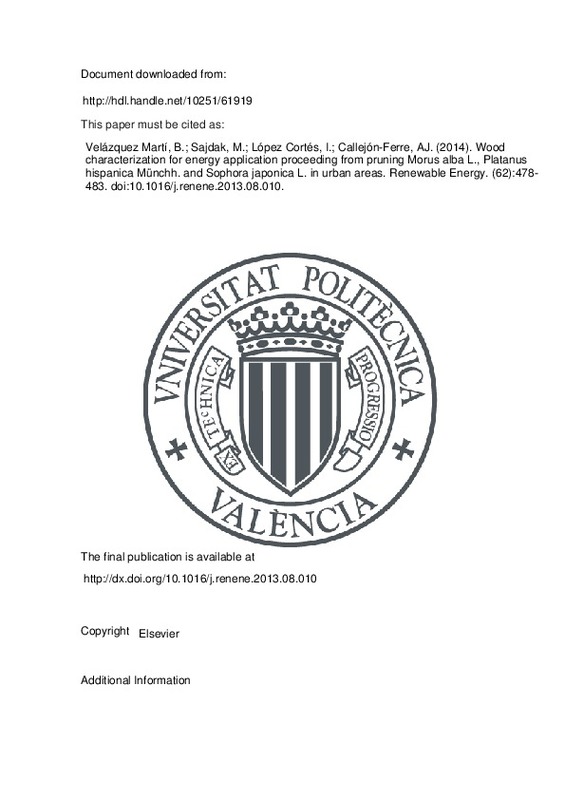JavaScript is disabled for your browser. Some features of this site may not work without it.
Buscar en RiuNet
Listar
Mi cuenta
Estadísticas
Ayuda RiuNet
Admin. UPV
Wood characterization for energy application proceeding from pruning Morus alba L., Platanus hispanica Münchh. and Sophora japonica L. in urban areas
Mostrar el registro sencillo del ítem
Ficheros en el ítem
| dc.contributor.author | Velázquez Martí, Borja
|
es_ES |
| dc.contributor.author | Sajdak, Magdalena
|
es_ES |
| dc.contributor.author | López Cortés, Isabel
|
es_ES |
| dc.contributor.author | Callejón-Ferre, A. J.
|
es_ES |
| dc.date.accessioned | 2016-03-16T10:10:03Z | |
| dc.date.available | 2016-03-16T10:10:03Z | |
| dc.date.issued | 2014-02 | |
| dc.identifier.issn | 0960-1481 | |
| dc.identifier.uri | http://hdl.handle.net/10251/61919 | |
| dc.description.abstract | Pruning urban forests generates significant amounts of lignocellulosic biomass every year. The energy potential of this biomass is unclear. The aim of this research was direct analysis of the gross calorific value (GO!), elemental composition and moisture content of Morus alba L., Platanus hispanica Munchh. and Sophora japonica L by means of laboratory equipment. This analysis allowed for further development of indirect GCV prediction models which are economically attractive and less time consuming to direct analysis. These models presented high coefficients of determination (R-2 0.66-0.96). It has been determined that the species with highest mean GCV is S. japonica L. (19615.68 kJ/kg-dry sample) whereas the one with the lowest is the M. alba L (18192.87 kJ/kg-dry sample). Elemental analysis showed highest carbon (48.22%), hydrogen (6.17%) and nitrogen (1.16%) content in S. japonica L in dry samples. Sulfur was constant at the level 0.05% for all analyzed species. Also percentage of bark and wood density were determined. Mean percentage of bark was highest for P. hispanica Miinchh. (13.05%) while wood density was highest for S. japonica L. (0.86 g cm(-3)). This way the research has proven that the biomass produced by pruning urban forests appears to be an interesting source of renewable energy. (C) 2013 Elsevier Ltd. All rights reserved. | es_ES |
| dc.language | Inglés | es_ES |
| dc.publisher | Elsevier | es_ES |
| dc.relation.ispartof | Renewable Energy | es_ES |
| dc.rights | Reserva de todos los derechos | es_ES |
| dc.subject | Urban forest | es_ES |
| dc.subject | Urban biomass waste | es_ES |
| dc.subject | GCV | es_ES |
| dc.subject | Elemental composition | es_ES |
| dc.subject.classification | PRODUCCION VEGETAL | es_ES |
| dc.subject.classification | ECONOMIA FINANCIERA Y CONTABILIDAD | es_ES |
| dc.subject.classification | INGENIERIA AGROFORESTAL | es_ES |
| dc.title | Wood characterization for energy application proceeding from pruning Morus alba L., Platanus hispanica Münchh. and Sophora japonica L. in urban areas | es_ES |
| dc.type | Artículo | es_ES |
| dc.identifier.doi | 10.1016/j.renene.2013.08.010 | |
| dc.rights.accessRights | Abierto | es_ES |
| dc.contributor.affiliation | Universitat Politècnica de València. Departamento de Ingeniería Rural y Agroalimentaria - Departament d'Enginyeria Rural i Agroalimentària | es_ES |
| dc.contributor.affiliation | Universitat Politècnica de València. Departamento de Producción Vegetal - Departament de Producció Vegetal | es_ES |
| dc.description.bibliographicCitation | Velázquez Martí, B.; Sajdak, M.; López Cortés, I.; Callejón-Ferre, AJ. (2014). Wood characterization for energy application proceeding from pruning Morus alba L., Platanus hispanica Münchh. and Sophora japonica L. in urban areas. Renewable Energy. (62):478-483. doi:10.1016/j.renene.2013.08.010 | es_ES |
| dc.description.accrualMethod | S | es_ES |
| dc.relation.publisherversion | http://dx.doi.org/10.1016/j.renene.2013.08.010 | es_ES |
| dc.description.upvformatpinicio | 478 | es_ES |
| dc.description.upvformatpfin | 483 | es_ES |
| dc.type.version | info:eu-repo/semantics/publishedVersion | es_ES |
| dc.description.issue | 62 | es_ES |
| dc.relation.senia | 249516 | es_ES |







![[Cerrado]](/themes/UPV/images/candado.png)

